PREDICTIVE CONTROL
WITH CONSTRAINTS
J.M.Maciejowski
Reader in Control Engineering
University of Cambridge
Fellow, Pembroke College, Cambridge
15 October 2000
�
ii
Copyright c1998{2000 J.M.Maciejowski. All Rights Reserved.
MATLAB and Simulink are registered trademarks of The MathWorks, Inc.
DMCPlus is a registered trademark of Aspen Technology Inc.
RMPCT is a registered trademark of Honeywell Inc.
Connoisseur is a registered trademark of Simulation Sciences Inc.
3dMPC is a registered trademark of ABB Automation Products AB.
World-Wide Web site for this book:
http://www.booksites.net/maciejowski/
�
Preface
Predictive Control, or Model-Based Predictive Control (‘MPC’ or ‘MBPC’) as it is
sometimes known, is the only advanced control technique | that is, more advanced
than standard PID control | to have had a signicant and widespread impact on
industrial process control. The main reason for this is that it is
The only generic control technology which can deal routinely with equipment
and safety constraints.
Operation at or near such constraints is necessary for the most protable or most ef-
cient operation in many cases. The penetration of predictive control into industrial
practice has also been helped by the facts that
Its underlying idea is easy to understand,
Its basic formulation extends to multivariable plants with almost no modica-
tion,
It is more powerful than PID control, even for single loops without constraints,
without being much more dicult to tune, even on ‘dicult’ loops such as those
containing long time delays.
Predictive control was developed and used in industry for nearly 20 years before
attracting much serious attention from the academic control community. This com-
munity tended to ignore its potential for dealing with constraints, thus missing its
main advantage. In addition, it tended to point to the fact that, when constraints
are ignored, predictive control is equivalent to conventional, though generally ‘ad-
vanced’, linear control, and hence apparently nothing new. This is true, but again
misses the important point that issues such as tunability and understandability are
crucial for the acceptance of a control technology, at least in the process control envi-
ronment. Fortunately the academic community has for some years now appreciated
that predictive control really does oer something new for control in the presence
of constraints, and has provided much analysis, and new ideas, to such an extent
that it has gone beyond current industrial practice, and is preparing the ground for
iii
�
iv
0. Preface
much wider application of predictive control | potentially to almost all control en-
gineering problems. The constant increase in computing speed and power certainly
makes that a real prospect.
In this book I have attempted to bring everything together. I have tried to convey
the simplicity of the underlying concepts of predictive control, but also to show how
it relates to existing control theory, and indeed how much more can be done with
it when its use is informed by a knowledge of standard control techniques, such as
state estimation, disturbance modelling, and frequency response analysis. Predictive
control involves optimization, and I have included details of how to solve at least
some of the optimization problems encountered. I have also tried to display the main
directions of current research, and give some indication of likely future directions,
both of research and of applications.
This book assumes that the reader has some previous exposure to control theory,
such as a rst course and some contact with state-space models. It will be suitable
for graduate students taking systems and control courses, but I hope that it will also
prove useful to practising industrial engineers. In order to increase its usefulness to
non-students, and also to alleviate the problem of prerequisites for students, I have
included a number of minitutorials. These are one-page summaries of topics, such
as observers or Lyapunov equations, that are needed in order to understand the ma-
terial at certain points. I believe that the minitutorials contain enough explanation
to allow the reader to follow the developments in the book, but of course they are
not meant to replace in-depth study of these important topics.
It is essential to have access to suitable software in order to solve any
non-trivial predictive control problems, and to gain experience of how it
actually works. This book assumes that the reader has access to MAT-
LAB, together with its Control System Toolbox and Model Predictive
Control Toolbox. Some simple MATLAB les have also been written,
and some les which augment those available in the Model Predictive
Control Toolbox| some of these also require the Optimization Toolbox.
All such additional software is available on this book’s World-Wide Web
site:
http://www.booksites.net/maciejowski/
The versions of software used for the preparation of this book were:
MATLAB
Control System Toolbox
Model Predictive Control Toolbox
Optimization Toolbox
5.3.1
4.2.1
1.0.4
2.0
My students Eric Kerrigan and Simon Redhead were responsible for most of the
modications to Model Predictive Control Toolbox functions which are available on
the web site.
�
v
This book originated in a course of lectures given at the Faculty of Aerospace Engi-
neering in Delft, during November and December 1997. I would like to thank Bob
Mulder, Hans van der Vaart, and Samir Bennani for inviting me to spend a sab-
batical term at Delft, for making all the arrangements, for making my stay at Delft
both pleasant and interesting, and above all for having enough vision to believe that
a course on predictive control was not out of place in an aerospace department. I
would also like to thank Ton van den Boom for giving me feedback on the rst few
chapters, Rob de Vries (both of TU Delft) for some valuable help with chapter 4,
and Hans van der Vaart for providing me with the linearised model of the Citation
aircraft which is used in a number of illustrative examples in the book. The use of an
aircraft example may seem quirky, since predictive control has been used almost ex-
clusively in the process industries. There are two reasons for this. Firstly, it reects
my conviction that predictive control has great potential in all application sectors,
as a result of continuing increases in real-time computational possibilities. Secondly,
most process control examples require considerable explanation of the context to
those who are not chemical engineers, whereas most readers will be able to under-
stand the (very simplied) aircraft example from their own experience. Of course
there are also examples based on process control in the book, and the major case
studies in Chapter 9 are both taken from process control.
I gave a graduate course based on the material in this book to the Centre for Process
Control Design at Lund University, and received several very valuable suggestions
from both faculty and students who attended that course. Andrew Ogden-Swift of
Honeywell Hi-Spec Solutions, Sean Goodhart of Aspentech, David Sandoz of SimSci{
Predictive Control, and Jacques Richalet of Adersa have all been very generous of
their time, have provided me with details of their companies’ products, and have
discussed the practicalities of predictive control most valuably and stimulatingly.
David Sandoz and David Clarke both provided extremely useful, but also encour-
aging, feedback at various stages of the development of the manuscript, and Fred
Loquasto of UC Santa Barbara read the almost-nal version in record time, and
picked up several errors and infelicities.
Any errors remain my own responsibility, of course.
J.M.Maciejowski
14 October 2000
�
vi
0. Preface
�
Contents
Preface
1 Introduction
1.1 Motivation . . . . . . . . . . . . . . . . . . . . . . . . . . . . . . . .
1.2 The ‘Receding Horizon’ Idea . . . . . . . . . . . . . . . . . . . . . . .
1.3 Computing the Optimal Inputs . . . . . . . . . . . . . . . . . . . . .
1.4 A Simple MATLAB Program . . . . . . . . . . . . . . . . . . . . . .
1.5 Oset-free Tracking
. . . . . . . . . . . . . . . . . . . . . . . . . . .
1.6 Unstable Plant . . . . . . . . . . . . . . . . . . . . . . . . . . . . . .
1.7 Early History and Terminology . . . . . . . . . . . . . . . . . . . . .
1.8 Predictive Control in the Control Hierarchy . . . . . . . . . . . . . .
1.9 General Optimal Control Formulation . . . . . . . . . . . . . . . . .
1.10 What Is In This Book . . . . . . . . . . . . . . . . . . . . . . . . . .
1.11 Problems
. . . . . . . . . . . . . . . . . . . . . . . . . . . . . . . . .
2 A Basic Formulation of Predictive Control
2.1 State-space models . . . . . . . . . . . . . . . . . . . . . . . . . . . .
2.1.1 Form of the model
. . . . . . . . . . . . . . . . . . . . . . . .
2.1.2 Linear model, nonlinear plant . . . . . . . . . . . . . . . . . .
2.1.3 First-principles models and system identication . . . . . . .
vii
iii
1
1
7
10
15
18
23
27
28
32
34
37
41
41
41
42
45
�
viii
CONTENTS
2.2 A Basic Formulation . . . . . . . . . . . . . . . . . . . . . . . . . . .
2.3 General Features of Constrained Predictive Control . . . . . . . . . .
2.4 Alternative State Variable Choices . . . . . . . . . . . . . . . . . . .
2.5 Allowing for Computational Delay . . . . . . . . . . . . . . . . . . .
2.6 Prediction . . . . . . . . . . . . . . . . . . . . . . . . . . . . . . . . .
2.6.1 No disturbances, Full state measurement . . . . . . . . . . . .
2.6.2 Constant output disturbance . . . . . . . . . . . . . . . . . .
2.6.3 Using an observer
. . . . . . . . . . . . . . . . . . . . . . . .
2.6.4
Independent and re-aligned models . . . . . . . . . . . . . . .
2.7 Example: Citation Aircraft Model
. . . . . . . . . . . . . . . . . . .
2.8 Problems
. . . . . . . . . . . . . . . . . . . . . . . . . . . . . . . . .
3 Solving Predictive Control Problems
3.1 Unconstrained Problems . . . . . . . . . . . . . . . . . . . . . . . . .
3.1.1 Measured State, No Disturbances . . . . . . . . . . . . . . . .
3.1.2 Formulation as a Least-Squares Problem . . . . . . . . . . . .
3.1.3
Structure of the Unconstrained Controller . . . . . . . . . . .
3.1.4 Estimated State
. . . . . . . . . . . . . . . . . . . . . . . . .
3.2 Constrained Problems . . . . . . . . . . . . . . . . . . . . . . . . . .
3.2.1 Formulation as a QP Problem . . . . . . . . . . . . . . . . . .
3.2.2 Controller Structure . . . . . . . . . . . . . . . . . . . . . . .
46
53
54
56
60
60
63
64
69
71
77
83
83
83
86
88
90
91
91
95
3.3 Solving QP Problems . . . . . . . . . . . . . . . . . . . . . . . . . . . 100
3.3.1 Active set methods . . . . . . . . . . . . . . . . . . . . . . . . 101
3.3.2
Interior point methods . . . . . . . . . . . . . . . . . . . . . . 107
3.4 Softening the Constraints
. . . . . . . . . . . . . . . . . . . . . . . . 110
3.5 Problems
. . . . . . . . . . . . . . . . . . . . . . . . . . . . . . . . . 117
�

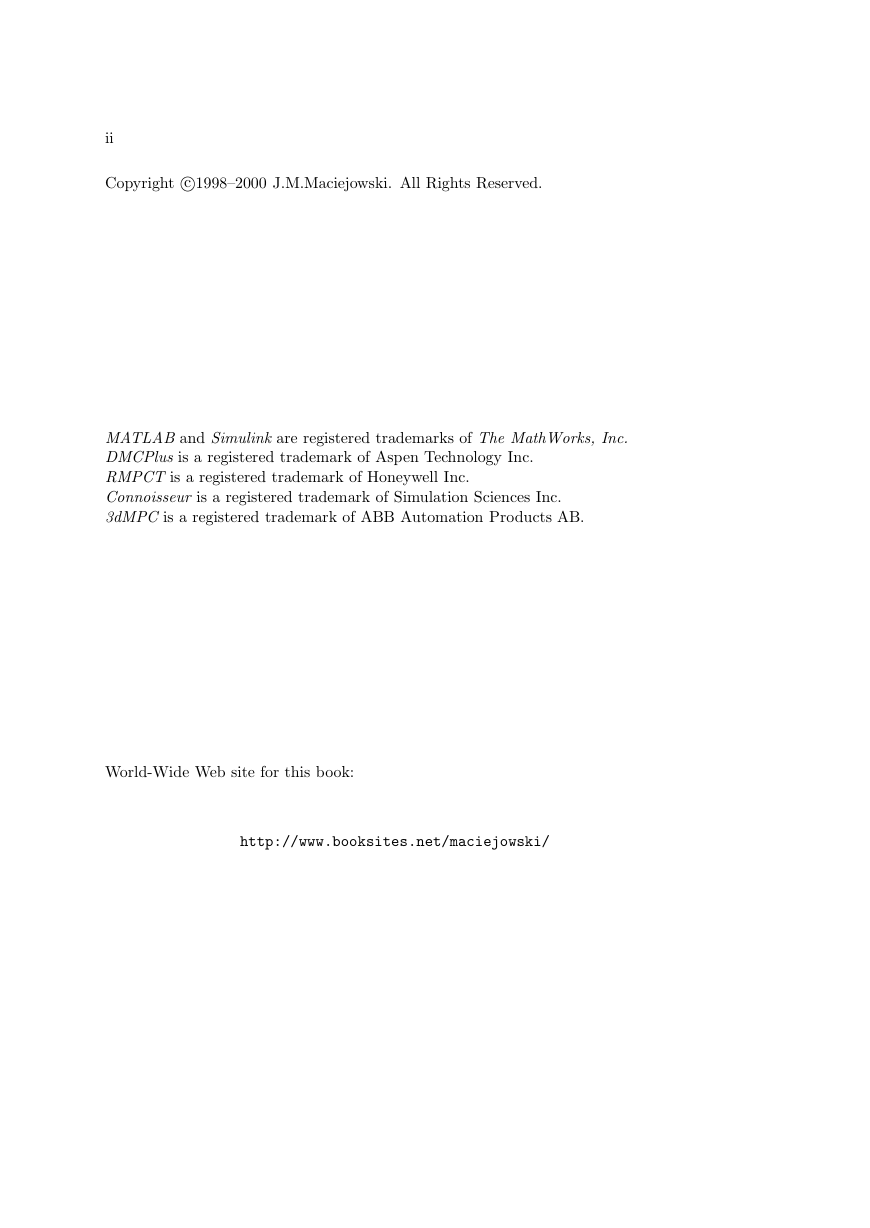
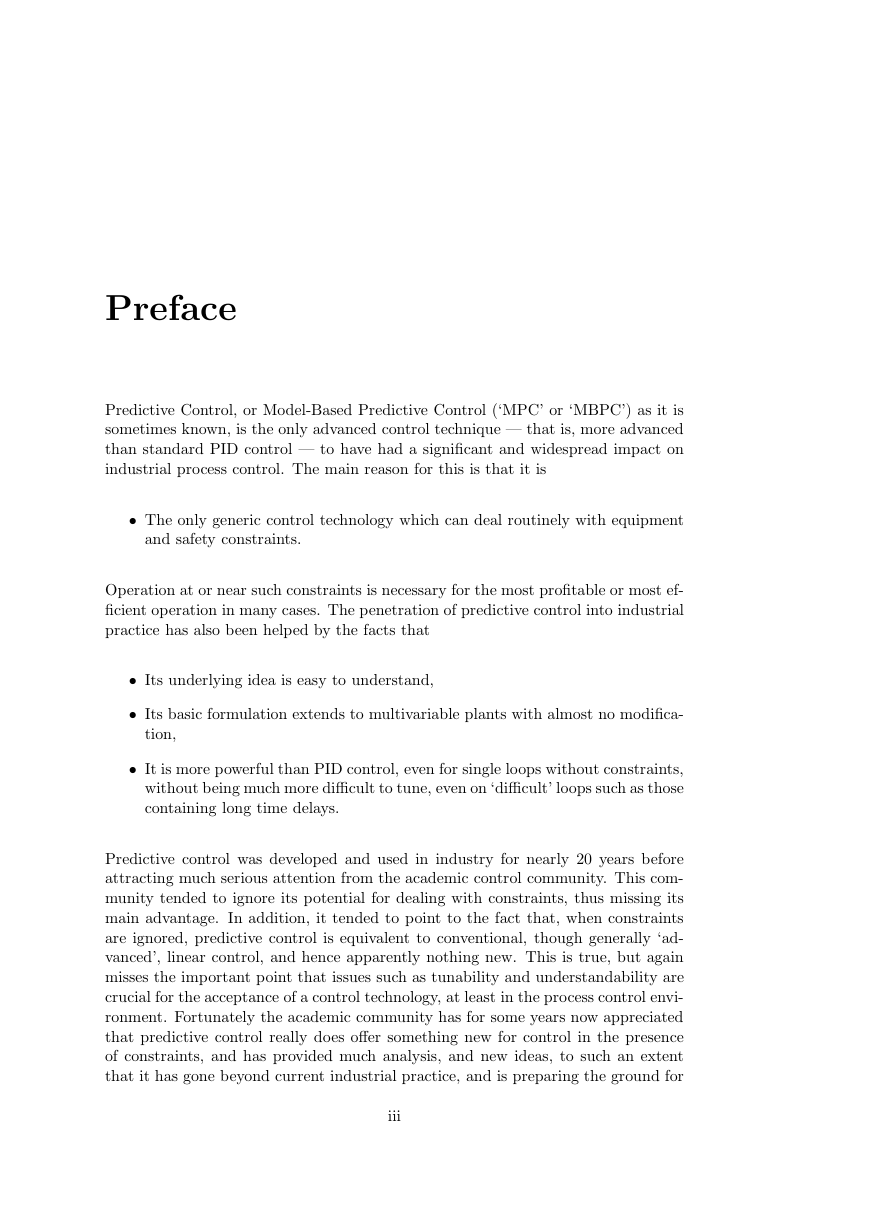
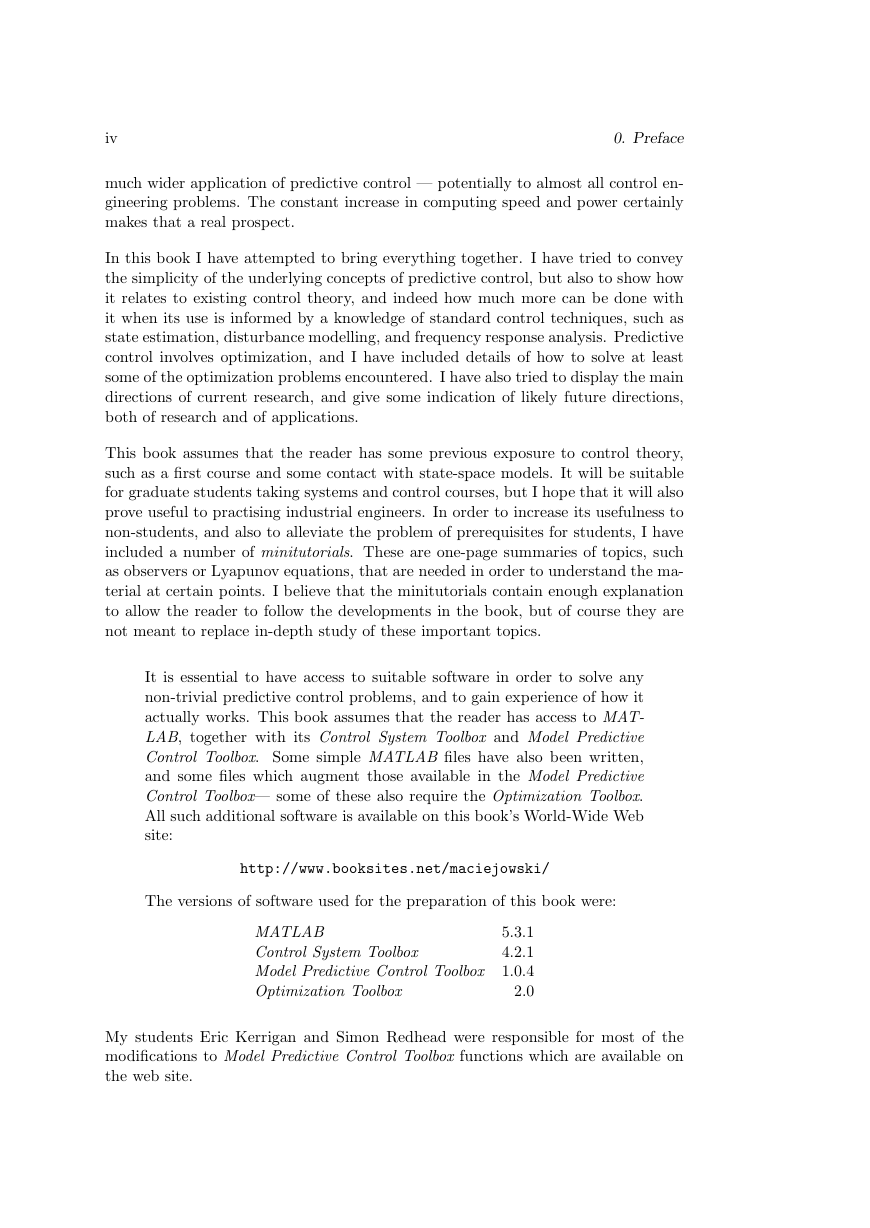
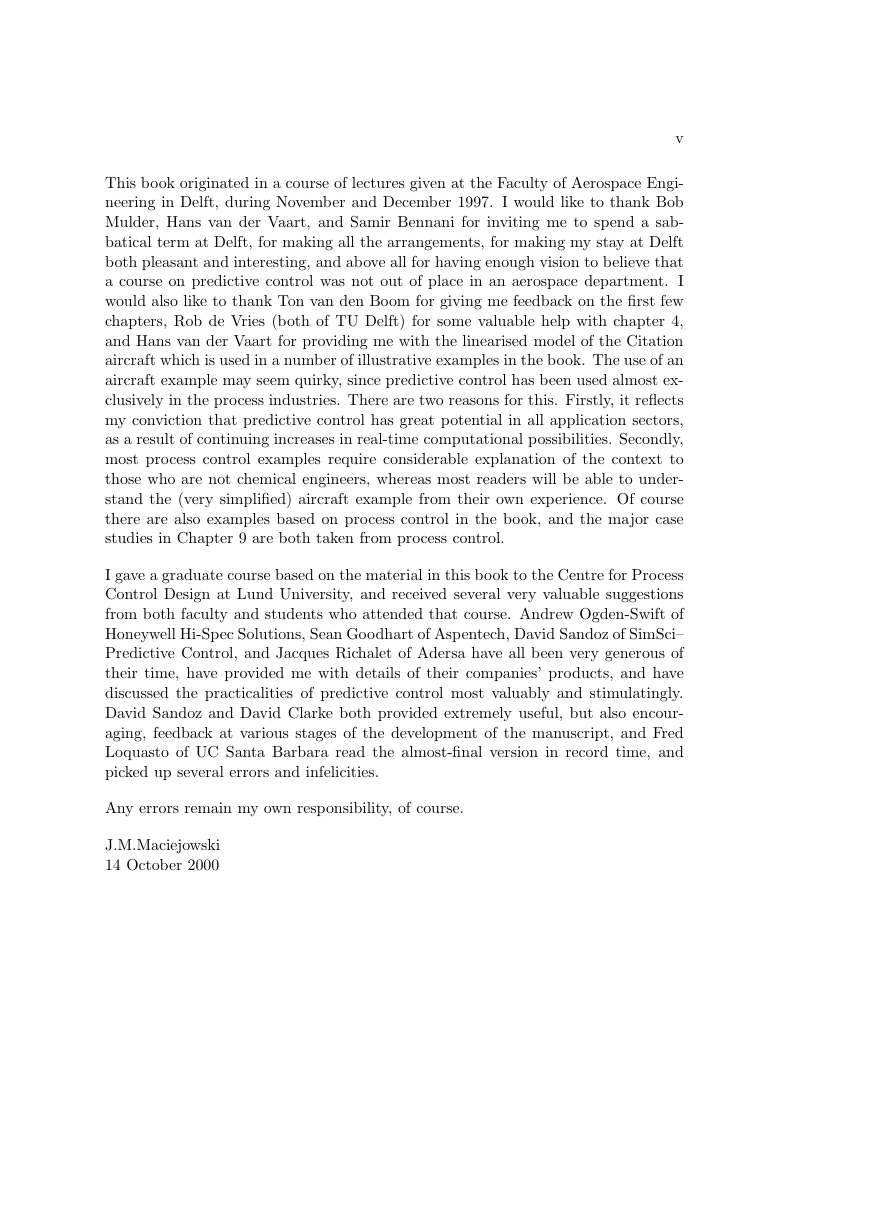

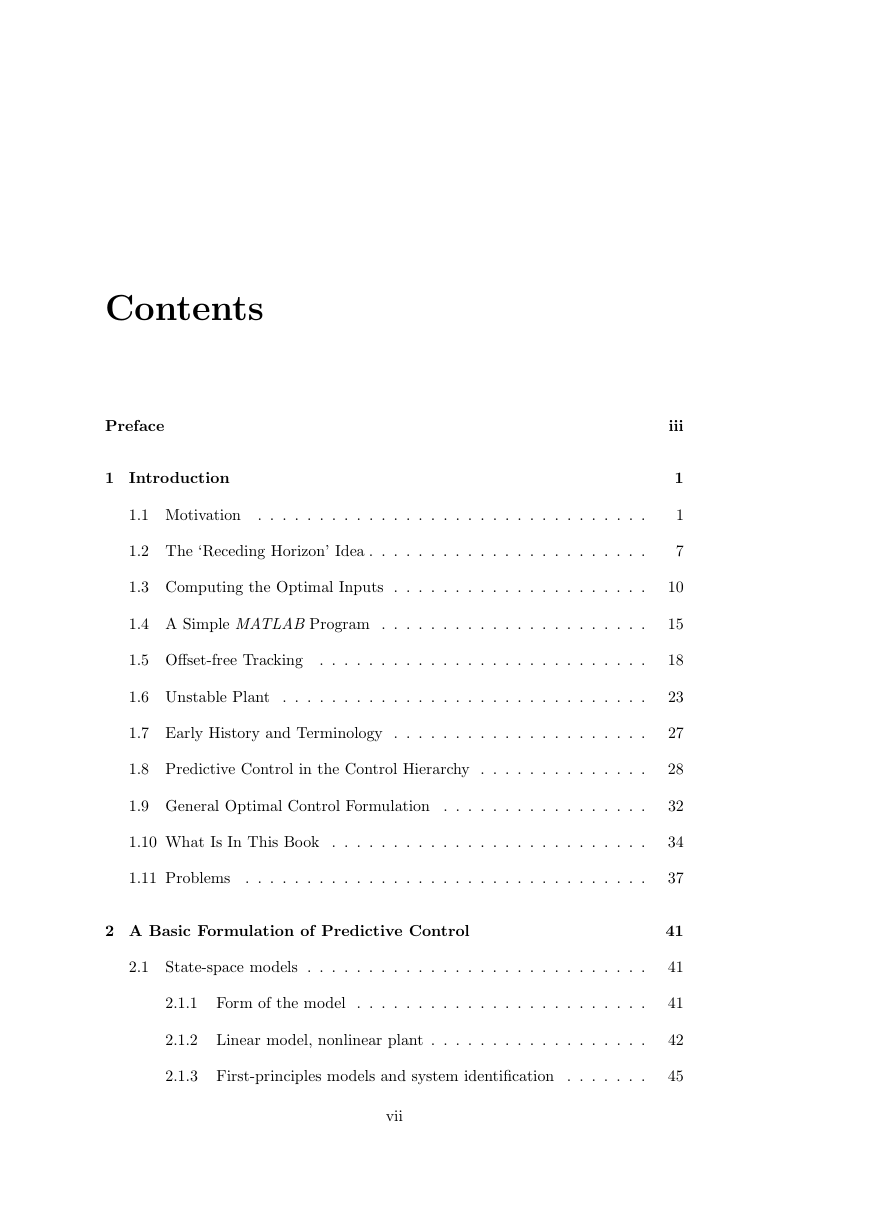
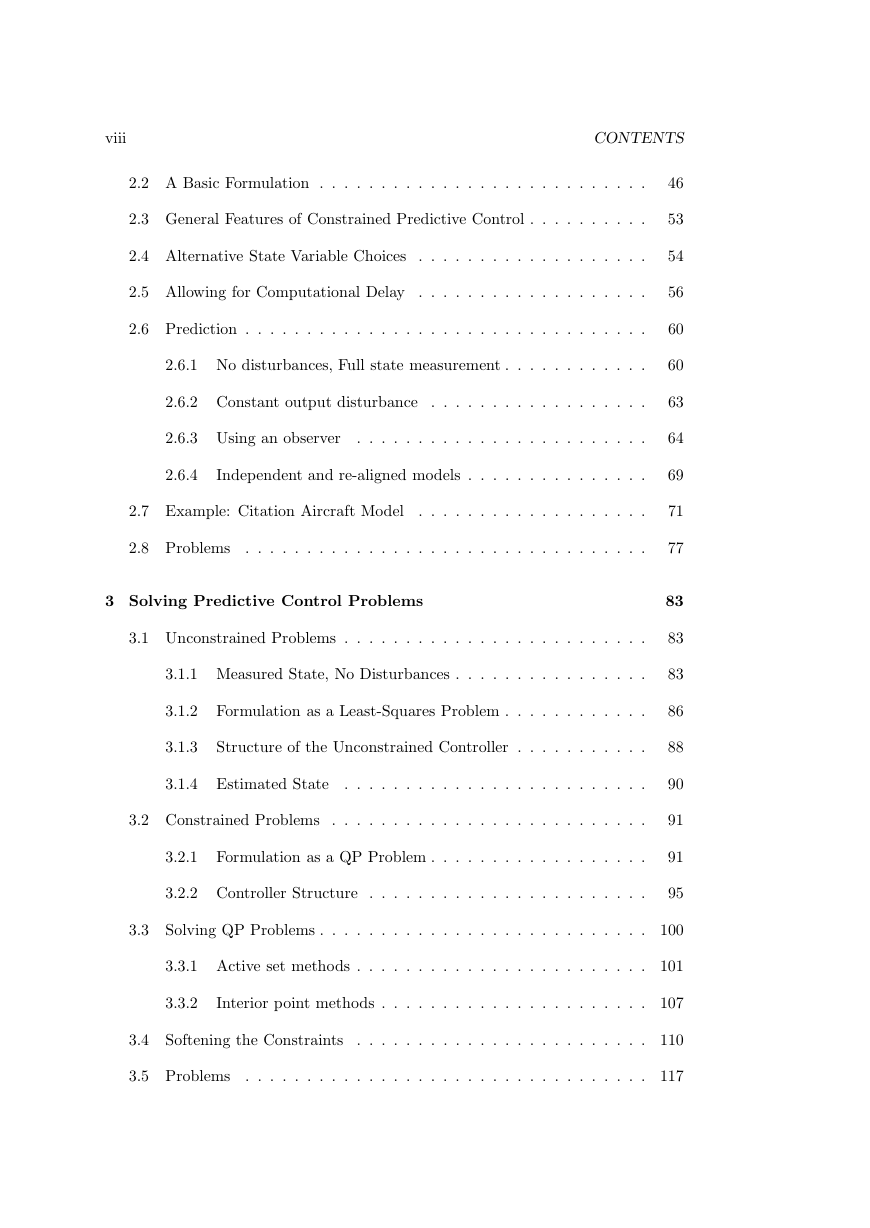








 2023年江西萍乡中考道德与法治真题及答案.doc
2023年江西萍乡中考道德与法治真题及答案.doc 2012年重庆南川中考生物真题及答案.doc
2012年重庆南川中考生物真题及答案.doc 2013年江西师范大学地理学综合及文艺理论基础考研真题.doc
2013年江西师范大学地理学综合及文艺理论基础考研真题.doc 2020年四川甘孜小升初语文真题及答案I卷.doc
2020年四川甘孜小升初语文真题及答案I卷.doc 2020年注册岩土工程师专业基础考试真题及答案.doc
2020年注册岩土工程师专业基础考试真题及答案.doc 2023-2024学年福建省厦门市九年级上学期数学月考试题及答案.doc
2023-2024学年福建省厦门市九年级上学期数学月考试题及答案.doc 2021-2022学年辽宁省沈阳市大东区九年级上学期语文期末试题及答案.doc
2021-2022学年辽宁省沈阳市大东区九年级上学期语文期末试题及答案.doc 2022-2023学年北京东城区初三第一学期物理期末试卷及答案.doc
2022-2023学年北京东城区初三第一学期物理期末试卷及答案.doc 2018上半年江西教师资格初中地理学科知识与教学能力真题及答案.doc
2018上半年江西教师资格初中地理学科知识与教学能力真题及答案.doc 2012年河北国家公务员申论考试真题及答案-省级.doc
2012年河北国家公务员申论考试真题及答案-省级.doc 2020-2021学年江苏省扬州市江都区邵樊片九年级上学期数学第一次质量检测试题及答案.doc
2020-2021学年江苏省扬州市江都区邵樊片九年级上学期数学第一次质量检测试题及答案.doc 2022下半年黑龙江教师资格证中学综合素质真题及答案.doc
2022下半年黑龙江教师资格证中学综合素质真题及答案.doc